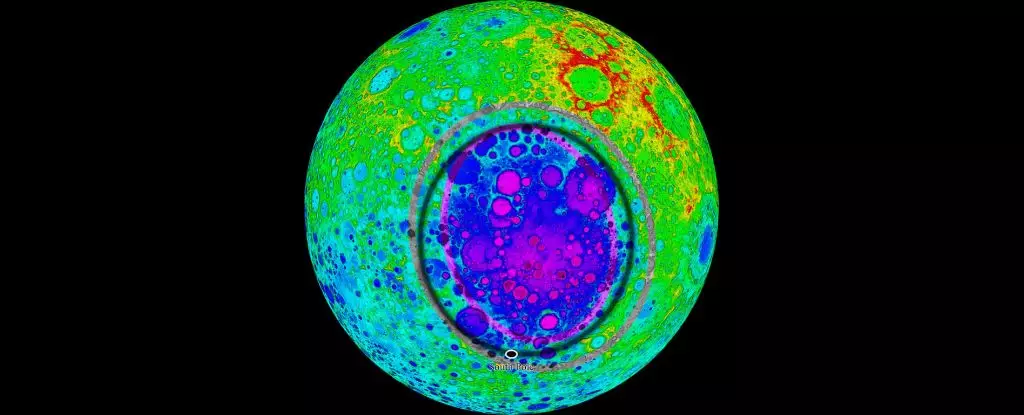The Moon serves as an extraordinary archive for our understanding of cosmic history. As Earth’s solitary natural satellite, its surface bears witness to an extraordinary timeline marked by relentless bombardments from celestial debris over billions of years. The South Pole-Aitken (SPA) basin, a massive geological feature that dominates the lunar landscape, represents one of the most significant markers of this history. Not only is it the largest crater on the Moon, but it also ranks among the most extensive craters throughout our Solar System, with a staggering diameter of approximately 2,500 kilometers (1,550 miles).
Despite its size and significance, studying the South Pole-Aitken basin poses substantial challenges for scientists. The basin, believed to be over 4 billion years old, has been obscured by time and subsequent impacts, further complicating our quest to unravel its mysteries. Recent research, however, points toward a potential reevaluation of the basin’s formation, suggesting that it may be larger than previously estimated and that the processes involved in its creation were not what scientists once assumed.
New Insights Through Precise Geology
Geologist Hannes Bernhardt from the University of Maryland highlights the difficulties inherent in comprehensively studying the SPA basin, noting that the immense scale of this geological structure hampers efforts to ascertain its true shape and size. Bernhardt’s team proposes that their findings could reshape prevailing theories about the basin’s formation while also enhancing our understanding of the Moon’s early geological evolution.
Prior research identified the South Pole-Aitken basin as the result of an oblique collision with a massive celestial body. This earlier hypothesis suggested that such an impact would have created an oval-shaped crater with debris primarily ejected in a single direction. However, Bernhardt and his colleagues sought to refine this model by meticulously examining the current geological features surrounding the basin. NASA’s Lunar Reconnaissance Orbiter, which has diligently mapped the lunar surface since 2009, was instrumental in their investigation.
The research team meticulously cataloged over 200 mountain features along the basin’s periphery, initially thought to represent remnants of the crater rim. However, their findings revealed a more circular formation than anticipated. This critical observation indicates a shift in understanding regarding the dynamics of the impact that formed this vast depression.
According to Bernhardt, the more rounded shape of the South Pole-Aitken basin indicates that the impactor struck the lunar surface at a steeper angle, akin to dropping a stone vertically into water. This newfound perspective implies a more uniform distribution of debris surrounding the basin than previously believed. If this model holds true, it opens incredible possibilities for future lunar exploratory missions, particularly those targeting the south pole region. It suggests that astronauts and robotic explorers may be able to access rare geological materials from the Moon’s mantle and crust that are usually beyond reach.
The implications extend far beyond mere exploration. The potential to uncover these primordial materials could unlock critical insights into the Moon’s formation. Among the competing theories, the prevailing idea is that the Moon originated from debris resulting from a cataclysmic collision between Earth and another celestial body early in the Solar System’s formation. Other hypotheses include the accumulation of material from a debris cloud or gravitational capture.
Further investigations also revealed intriguing gravitational measurements that indicate higher density materials beneath the basin’s crust compared to surrounding lunar regions. This curious characteristic may point toward the existence of a dense asteroid fragment buried within the basin, making the steep access to this geological treasure chest even more tantalizing.
Bernhardt’s research underscores the immense relevance of the South Pole-Aitken basin for upcoming lunar missions, including NASA’s Artemis program. Accessing pristine samples from the Moon’s early history could illuminate numerous questions surrounding its formation, and even offer clues about the broader history of our Solar System.
As we continue to rethink and reevaluate the geological processes that have shaped the Moon, the South Pole-Aitken basin stands as a crucial subject of study. By delving deeper into its geological mysteries, scientists are poised to unlock secrets that could transform our understanding of lunar geology and, by extension, the evolution of our cosmic neighborhood. As humanity prepares for a new era of space exploration, these insights will undoubtedly shape our endeavors in understanding the Moon and beyond.


Leave a Reply